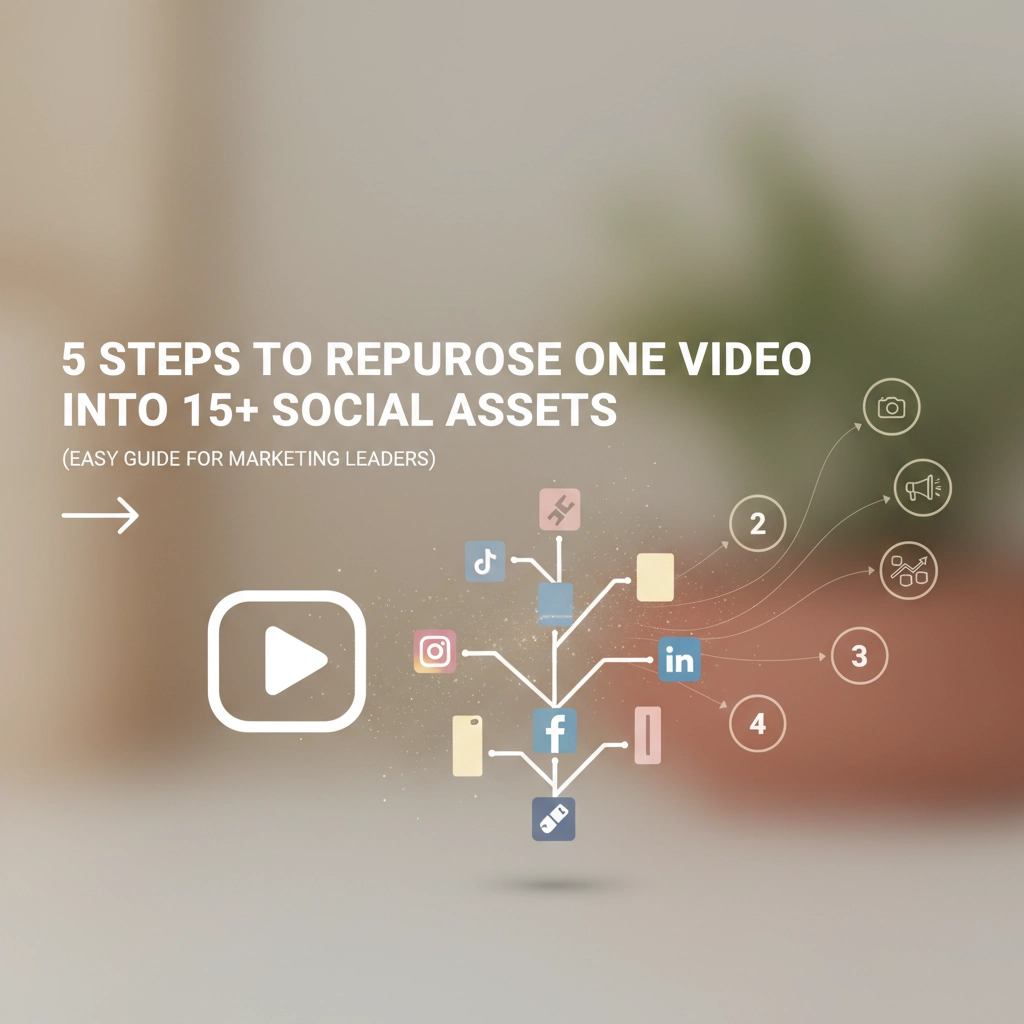5 Steps How to Repurpose One Corporate Video Into 15+ Social Assets (Easy Guide for Marketing Leaders)

Here's the truth: you probably spent weeks planning that corporate video, thousands of dollars producing it, and now it's sitting on YouTube with 47 views (23 of which are from you checking if it uploaded correctly). Sound familiar?
What if I told you that one video could become 15+ pieces of content that work across every platform your audience actually uses? You'd probably think I'm overselling, right? But here's the thing, smart marketing leaders are already doing this, and it's not rocket science.
Let's break down exactly how to turn your single corporate video into a content goldmine that keeps giving long after the cameras stop rolling.
Step 1: Build Your Content Foundation (And Actually Plan Ahead)
Before you start chopping up your video like a late-night infomercial, you need the right raw materials. Your hero video should be substantial, think webinars, product demos, client testimonials, or educational content that actually teaches something valuable.
Here's what separates the pros from the amateurs: during production, make sure you export three essential files. First, your full video in the highest quality possible. Second, extract the audio track as a separate file (trust me on this one). Third, grab any slides, graphics, or visual materials used during filming.

The best videos for repurposing are those packed with golden nuggets of information. A 20-minute product demo can yield more social content than a dozen random Instagram posts because each feature explanation becomes its own mini-story.
Pro tip: If you're working with a video production company (like, say, a certain film studio in Whitby, Ontario), ask them to capture behind-the-scenes footage and multiple angles during filming. This extra content becomes bonus material for your repurposing strategy.
Step 2: Hunt Down Your Video's Greatest Hits
Time to put on your detective hat. Watch your entire video and identify moments that could stand alone as shorter clips. You're looking for the good stuff, powerful quotes, surprising statistics, "aha" moments, and clear explanations of complex topics.
Create timestamps for these segments, but think like your audience: what would make them stop scrolling? A 30-second clip explaining why your software saves 3 hours per week hits different than a 30-second clip of generic corporate speak.
Each segment should tell a complete micro-story. Start with a hook, deliver value, and end with either a resolution or a cliffhanger that makes people want to see the full video.

Don't just look for the obvious highlights, sometimes the most engaging content comes from unexpected moments. That casual aside about industry trends? Perfect LinkedIn post. The moment your CEO laughs at their own mistake? Humanizing Instagram story material.
Step 3: Master the Platform Game
Here's where most people mess up: they create one piece of content and blast it everywhere. Each platform has its own personality, and your content needs to match.
For Instagram and TikTok, you want punchy, attention-grabbing clips with bold text overlays and captions that hook viewers in the first 3 seconds. These platforms love vertical video, quick cuts, and content that feels native to the feed.
LinkedIn prefers longer-form educational content. That 2-minute explanation of your process? Perfect for LinkedIn video. Add a compelling caption that starts a conversation, and you've got engagement gold.
YouTube Shorts want the best of both worlds, slightly longer than TikTok but more polished than Instagram. Use these for tutorials, quick tips, or behind-the-scenes content.

Don't forget about the audio-first platforms. Your video's audio track can become a podcast episode, reaching an entirely different audience who prefers consuming content while commuting or exercising.
Create multiple versions of your best clips: square for Instagram feed, vertical for Stories and Reels, horizontal for YouTube and LinkedIn. Yes, it's more work upfront, but the reach multiplier is worth it.
Step 4: Create the Supporting Cast
Your video content is the star, but it needs a strong supporting cast to really shine. Start by transcribing your video: this gives you written content for blog posts, email newsletters, and social media captions.
Extract powerful quotes and turn them into quote graphics. Pull out statistics and create infographics. Those behind-the-scenes moments? Perfect for carousel posts that show your company's personality.
Here's a move most people miss: create educational content around your video's topic. If your video is about email marketing, create a checklist, a template, or a "common mistakes" infographic. This positions you as the expert while driving traffic back to your main video.

Think about your audience's journey. Someone might see your quote graphic on Instagram, engage with your carousel post on LinkedIn, read your blog post, and finally watch your full video. Each piece of content should naturally lead to the next.
Step 5: Build Anticipation and Keep the Momentum
Your content strategy shouldn't just dump everything at once. Create promotional content that builds anticipation and extends your video's lifespan.
Teasers work incredibly well: use different clips and messaging to target various segments of your audience. A 15-second teaser highlighting cost savings might target budget-conscious managers, while a clip showcasing innovation appeals to forward-thinking executives.
Create countdown posts, "coming soon" graphics, and announcement content. Build a series around your video's topic: if it's about productivity, create a week-long series with different aspects each day.

Don't forget promotional advertisements. Extract the most compelling soundbites and calls-to-action from your video to create ads that feel authentic rather than salesy.
Your Content Arsenal: 15+ Assets Breakdown
Here's exactly what you can create from one corporate video:
Short-form Video Content (7-9 assets):
- 3-4 platform-specific clips (Instagram Reels, TikTok, LinkedIn video, YouTube Shorts)
- 2-3 teaser trailers targeting different audiences
- 2 promotional advertisements with strong calls-to-action
Visual Assets (4-5 pieces):
- Quote graphics featuring key insights
- Statistical infographics from your data
- Behind-the-scenes photo carousels
- Announcement and countdown graphics
Written Content (3-4 assets):
- Long-form blog post expanding on video insights
- LinkedIn article series breaking down key points
- Email newsletter content for your subscribers
- Social media captions and standalone posts
Audio Content (1-2 assets):
- Podcast episode from your extracted audio
- Audio clips for emerging voice-first platforms
The math is simple: invest once in quality video production, then multiply that investment across 15+ pieces of content. Your cost per asset drops dramatically, and your reach expands exponentially.
Making It All Work Together
The secret sauce isn't just creating more content: it's creating content that works as a system. Each piece should feel natural to its platform while maintaining your brand message and guiding viewers toward your ultimate goal, whether that's watching the full video, visiting your website, or contacting your team.
Ready to turn your next corporate video into a content marketing machine? The team at North Brothers Films specializes in creating video content that's built for repurposing from day one. We'll help you plan, produce, and optimize your video strategy so every dollar spent on production delivers maximum marketing impact.
Because here's the thing: great video content deserves to be seen by more than just your immediate network. With the right repurposing strategy, that one video becomes the gift that keeps on giving, working harder for your brand across every platform that matters.
